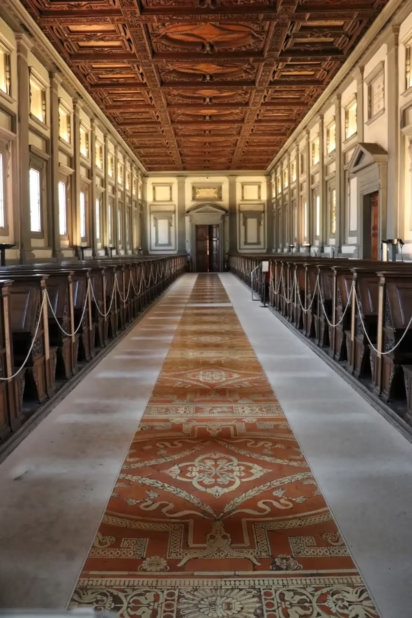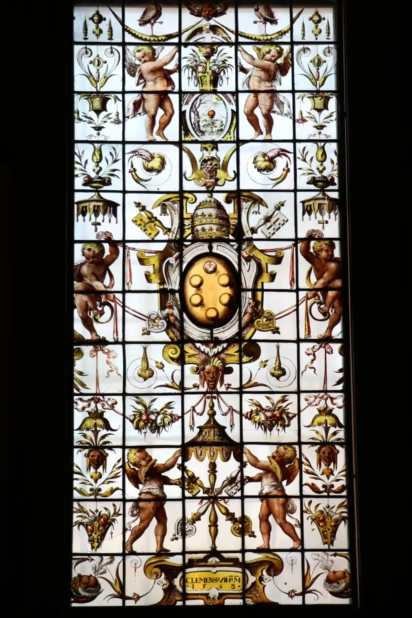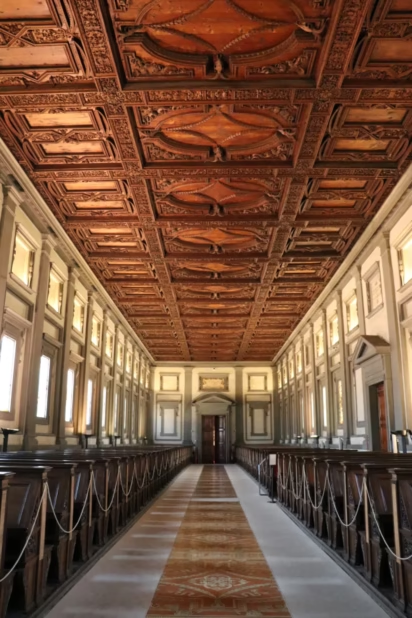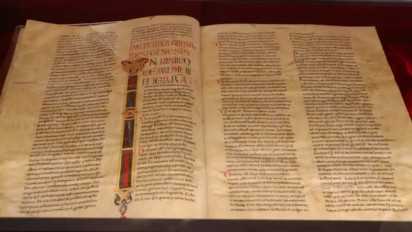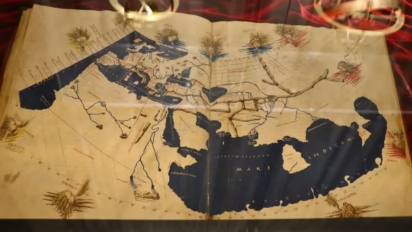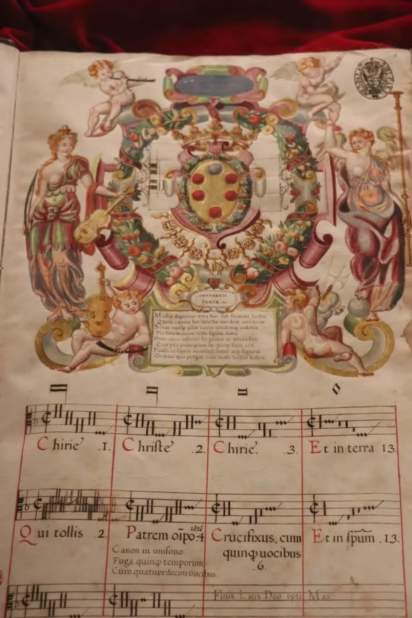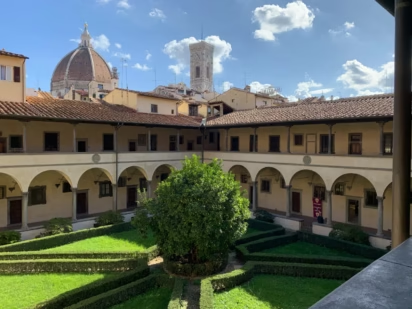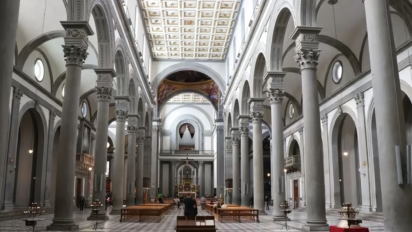The Biblioteca Medicea Laurenziana is the Medici library designed by Michelangelo in the San Lorenzo complex in Florence. It is also a major working library.

The Laurentian Medici Library (Biblioteca Medicea Laurenziana) is a major library in Florence. For tourists, the main sight is the magnificent Renaissance reading room designed by Michelangelo. The entire room and furnishings are authentic sixteenth-century. Only a small number of historic works are on rotating display — causal visitors do not get to see the working library or book vaults. Access to the Medici’s library is from the upper level of the galleries in the cloister of San Lorenzo (Note separate tickets and opening hours from the rest of the San Lorenzo complex! The Medici Library is only open weekday mornings)
→ Top museums, churches, and sights in Florence are open mostly as normal in 2025 — see 2025: Florence Opening Hours of Top Sights, Museums, and Churches for the latest information and opening hours. The Firenzecard is again sold while the Turbopass Florence City Pass is a good alternative that includes online timeslot reservations for both the Uffizi and Accademia.
Laurentian Medici Library by Michelangelo in San Lorenzo
Michelangelo designed the beautiful Renaissance Biblioteca Medicea Laurenziana library for the Medici Pope Clement VII. Michelangelo supervised work from 1523 to 1534 when he moved to Rome. On the instructions of the Medicis, Vasari, Ammannati, and others completed the work but strictly followed the original plans of Michelangelo.
Access is via a vestibule with a monumental stone staircase, which Michelangelo originally intended to be walnut.
The measurements of the reading room are impressive — 46.2 m long, 10.5 m wide and 8.4 m high. As the lower floor of the monastery complex determined the size of the dimensions of the reading room, Michelangelo had to use several techniques to reduce the weight of the walls to prevent structural damage.
Even more impressive than the size is that basically all items in the reading room are original from the 16th century and mostly to the designs of Michelangelo.
The plutei (wooden reading benches) served both as reading bookstands and to house the large codexes. These large codexes were chained physically to the plutei — readers had to change seats to read a different book.
The Medicis loved good ceilings and this fine ceiling is no exception. It was carved from lime wood by Giovan Battista del Tasso to Michelangelo’s designs. The windows are probably by Flemish artisans to designs by Vasari while the terra-cotta floor is by Niccolo Tribolo.
Behind the reading room, historic codexes and books are shown in rotating exhibitions. It often follows a specific theme. Only a small number of books is on display at any given time and the rest of the library and book collections are not open for tourist visits.
Collection of the Biblioteca Medicea Laurenziana
The Medicis opened the library to scholars in 1571 and it remains a major functioning library. The collection includes around 11,000 manuscripts, of which 700 are from before the 11th century. It further has 2,500 papyri, 43 ostraca, 566 incunabula, 1,681 16th-century prints, and 126,527 prints of the 17th to 20th centuries.
Amongst the collection is the Nahuatl Florentine Codex (a major source of pre-Conquest Aztec life), the Codex Amiatinus (the earliest surviving manuscript of the Latin Vulgate Bible), a Virgil of the 4th century and a Horace of the 10th, and around 100 codices of Dante.
Many of these works are available online. Serious scholars may apply in advance to study material in the library as well. Tourists see only the works selected for display on any given day.
Visitor Information for the Biblioteca Medicea Laurenziana
Admission to the Medici Library is €5. (Combination tickets with the San Lorenzo Basilica and Crypt give a small discount but not different opening hours. The Medici Chapel with Michelangelo statues is charged separately.)
The Firenze Card is not accepted. It used to be, so it is worth asking before buying tickets.
Buy tickets in the cloisters, entrance to the left of the basilica when facing the facade-less church.
Access to the magnificent Biblioteca Medicea Laurenziana is from the upper level of the galleries in the cloister. Note the shorter opening hours — don’t cut it too fine, as the guard at the door may refuse entry even if a ticket was bought only a few minutes earlier (as the ticket is then valid the following day).
Opening hours are weekdays from 10:00 to 13:30 — last admission at least half an hour before closing time. The library is closed on weekends and all public holidays.
The Laurentian Medici Library generally gets good reviews on Tripadvisor — bad ratings are mostly due to visitors caught out by the early closing time.
The rest of the San Lorenzo complex is among the top attractions in Firenze. The Basilica by Brunelleschi and several items by Donatello are seen as one of the first Renaissance buildings ever built while the Medici Chapels not only served as the mausoleum of the Medicis but also have several Michelangelo statues.
More Articles on Florence Sights
The high season in Florence is increasingly long: Easter, May, July, August, and the Christmas holidays are especially busy. November and January to mid-March are the only quiet months, except for the February school holiday week. Plan and book time-slot reservation tickets and tours when available in advance — the Accademia and the Uffizi are again sold out weeks in advance. Top sights are quieter directly at opening time or in the late afternoon.
→→ Opening hours for top sights in 2025 — most sights have long hours but advance time-slot reservations are always sensible.
- Tips on Buying Tickets for the Uffizi Museum
- Tips on Buying Skip-the-Line Tickets for the Accademia (Michelangelo’s David)
- See Michelangelo’s David in the Galleria dell’ Accademia
- Visit the Duomo sights: Cathedral (Duomo), Baptistery (Battistero), Bell Tower (Campanile), Dome (Cupola), Museum (Museo), and Tickets + Opening Hours
- Visit the Bargello Museum of Sculpture (Donatello’s Davids)
- Visit San Marco Museum to see the frescoes and altarpieces painted by Fra Angelico.
- Visit Santa Maria Novella Church and Museum to see medieval and Renaissance Art.
- Visit Santa Croce for Giotto Frescoes and Michelangelo’s Grave
- San Lorenzo complex: Visit the Basilica for Renaissance Art, See the Laurentian Medici Library by Michelangelo, and Visit the Medici Chapels (Michelangelo Statues)
- Visit the Orsanmichele Church and Museum with sculptures.
- Save on Sightseeing in Florence with the Firenze Card (again available but not including transportation or the Duomo sights, or consider the Turbopass Florence City Pass that includes online timeslot reservations for both the Uffizi and Accademia.
- Travel to Pisa to see the Field of Miracles and the Leaning Tower of Pisa.
- Visit the magnificent Romanesque-Gothic cathedral in nearby Siena.
- Save on top Italian designer fashion at The Mall Factory Outlet Stores.
Florence Resources
- The official website of the Firenze Tourist Office is a bit cumbersome but has very useful information. Especially the pdf (alternative link) with the opening hours of all major sights. Unfortunately, it is only available for the current month but it is the second last line on opening hours — the final say is the guard at the door, NOT the ticket window!
- Get Your Guide offers tours of all major sights while Tiqets sells online tickets for many top sights in Florence.
- Book luggage storage online and explore Florence more easily on foot.
- Trainline is good for booking online train tickets in Italy and most of Europe.
